In the era of industrial 4.0, data is a new element of production that interacts with traditional manufacturing, business process and organizational structure. The massive data collected by sensors is transmitted through a 5G network, converged in the private cloud of enterprises, and then fed back to the physical world through data mining analysis and AI service, helping enterprises greatly improve efficiency, reduce product costs, increase the efficiency of resource allocation, and achieve digital transformation. As the nerve center that supports enterprise digitalization, the 5G network completes data upload and download and associates the industry brain like AI and big data with perception and execution organs like industrial sensors. It plays a key role in building a private campus network for digital transformation.
NodeEngine Provides Simplest 5G Private Network Solution
At present, enterprise businesses are divided into two categories: production in the campus and data interaction outside the campus. Among them, the security and privacy of production data is crucial to the competitiveness of enterprises. Ensuring core production data does not leave the enterprise campus has therefore become the most basic requirement of 5G network in enterprise digitalization.
One purpose of enterprise digital transformation is to uniformly access a variety of fragmented and relatively independent terminals, enable cross-layer protocol interconnection, and optimize production resource allocation to achieve better market competitiveness. Therefore, enterprises focus on maximizing the reuse of existing equipment, reducing construction costs of their private campus networks, shortening the deployment period, and lowering O&M costs.
5G private network solutions fall into two kinds: one is based on dedicated frequency bands, and the other is to share radio network resource with the public network. The main features of the second kind are analyzed below, as shown in Table 1.

Based on the above analysis, deploying the computing power down to the sites with local traffic offloading can help enterprises maximize their network resource utilization and save O&M costs. ZTE has launched NodeEngine—the industry’s first gNB-centered solution for private campus networks (Fig. 1). Only by inserting one computing board into the gNB in the campus can NodeEngine build a 5G private network with local traffic offloading function within one hour.
The NodeEngine solution has the following advantages:
—
Shortest and most reliable local transmission path over a 5G network: Once the data generated from a terminal is uploaded to the gNB through 5G new radio, it will be forwarded directly to the private server through NodeEngine. This can effectively reduce the latency and protect data from attack with the least number of forwarding nodes. The average end-to-end transmission latency is no more than 10 ms.
—
Simplest deployment and convenient O&M: The NodeEngine solution can be co-deployed with existing 5G sites. No engineering survey or interoperability with core network elements are needed. NodeEngine can be operated and managed uniformly with 5G gNB, helping operators quickly build a private network for enterprise customers.
—
Optimal hardware costs: When there are multiple sites in the campus, only by inserting one computing board into one site can the NodeEngine solution serve all sites. The simplest private network is thus built at controllable costs.
The NodeEngine solution also provides flexible offloading strategies, including IP 5-tuple/DNS, specific PLMN-ID and slice ID, to meet the needs of enterprises in different scenarios such as traditional campuses, large campuses or specific services in the public network.
NodeEngine Builds Precise 5G Private Campus Network
With the development and large-scale deployment of 5G and the maturity of 5G industry chain, vertical applications of 5G private campus network are gradually extending from early mobile office and surveillance video transmission to latency-sensitive applications such as motion control and robot/AGV collaborative control. These applications require different bandwidth, latency and reliability. For example, industrial control applications require an E2E transmission latency of less than 10 ms, while remote control applications expect that videos on site can be uploaded in 150 ms with a bandwidth of 4M (1080p). There are also a large number of real-time communications between terminals, which requires production network to operate continuously and stably. In addition to local transmission of application data, ZTE‘s NodeEngine solution also provides more attractive services to serve private campus applications with the best performance.
—eBridge service: NodeEngine acts as a bridge between terminals and the campus network, and supports their interoperability in the campus without changing the original configuration and working mechanism of terminals. It is a perfect replacement of the wired or Wi-Fi intranet.
—Low-latency steaming service: NodeEngine shortens the end-to-end video upload latency by 80%. When combined with ZTE's self-developed video gateway that uses highly efficient video coding/decoding and distribution technology and acts as CPE on the terminal side, NodeEngine reduces the latency to 100 ms and thus accelerates mobile video applications.
—Edge QoS service: NodeEngine provides SLA guarantee for different campus applications. It detects the characteristics of applications in the private campus network, calculates and analyzes them through AI learning. Then it gives a reasonable resource allocation policy to meet performance requirements of the applications in terms of bandwidth, latency and reliability.
—Self-service portal: NodeEngine allows enterprises to manage their private networks on their own. Based on unified network operation and maintenance, operators provide self-service portals for enterprises in domain-authorized management mode. Enterprises can realize self-access, self-maintenance, self-alarm and self-traffic-management of their private campus networks.
ZTE has been committed to building an intelligent on-demand private network for operators and their enterprise customers. Through local traffic offloading and diverse value-added services provided by its NodeEngine solution, ZTE can accelerate the incubation of 5G applications in the campus and thus promote digital campus transformation.